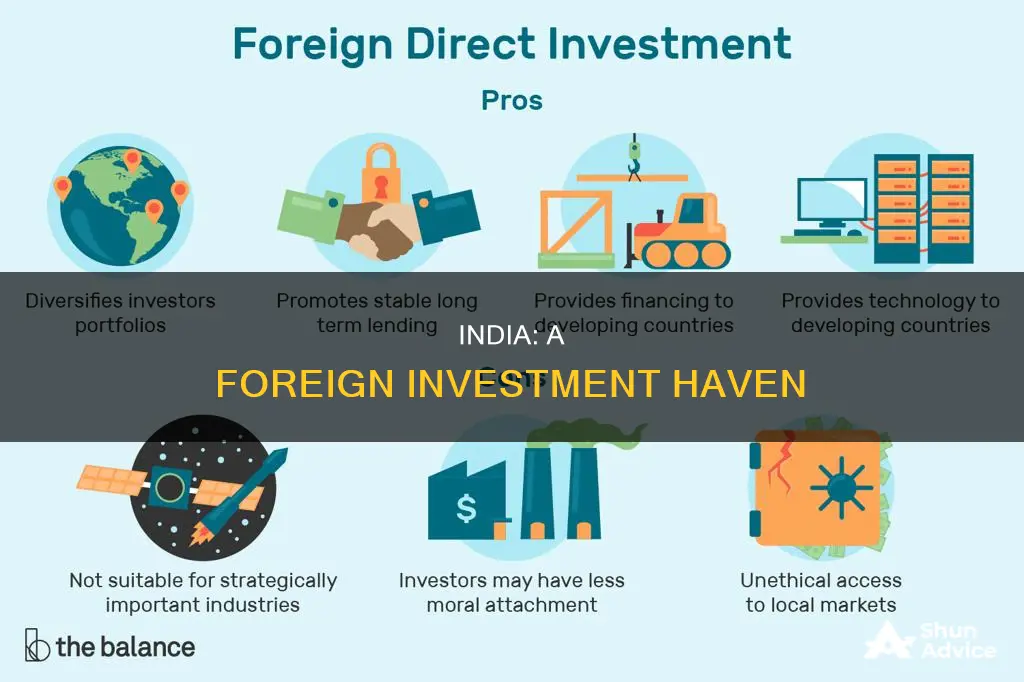
India is one of the world's fastest-growing economies, with a large youth population and a thriving tech and startup ecosystem. The country has strong ties with Silicon Valley, making it an attractive prospect for foreign investors. India's stock markets are the fourth largest in the world, and foreign investors can choose from several investment routes, including foreign direct investment, foreign portfolio investment, and non-resident investments. The country's infrastructure development and economic growth prospects, combined with its maturing tech and startup ecosystem, make it an appealing destination for investors seeking diversification and growth opportunities.
What You'll Learn
- India's stock markets are the fourth largest in the world
- India has the world's largest youth population
- India is set to become one of the largest manufacturing hubs in the world by 2030
- India ranks 39th on the Global Competitiveness Index
- India has the third-largest group of scientists and technicians in the world

India's stock markets are the fourth largest in the world
India's stock markets have become the fourth largest in the world, overtaking Hong Kong's. The total value of shares on Indian exchanges hit $4.33 trillion, compared to Hong Kong's $4.29 trillion. India passed the $4 trillion mark on December 5, 2023, with half of that value built up in the preceding four years.
The stock market has been galvanised by a growing number of retail investors and strong corporate earnings. Overseas funds poured over $21 billion into Indian stocks last year, and the S&P BSE Sensex, a benchmark index tracking Indian stocks, notched an eighth consecutive year of gains.
India's rise as a stock market power has coincided with a historic slump in Hong Kong, where some of China's most influential and innovative firms are listed. Beijing's stringent anti-Covid-19 curbs, regulatory crackdowns on corporations, a property-sector crisis, and geopolitical tensions with the West have all combined to erode China's appeal as the world's growth engine.
India's stock market growth is also driven by its stable political setup and a consumption-driven economy that remains one of the fastest-growing in the world. The country's population overtook China's last year, and it has been gearing up for boom-time economic growth and a flood of foreign investment.
India's stock markets offer foreign investors a fast-growing alternative to China's floundering stock indexes. Foreign investors can use the Foreign Portfolio Investment (FPI) route to invest in shares of Indian listed companies. While there are no restrictions on investing in Indian companies via this route, an FPI cannot hold more than 10% in a listed company. All FPI investments must be in Indian rupees and are taxed at the same rates as domestic investors.
Attracting Foreign Investment: Strategies for India's Growth
You may want to see also

India has the world's largest youth population
India has the largest youth population in the world, with 65% of its people under 35. This equates to 600 million people aged between 18 and 35. India's population is expected to rise from 1.37 billion to 1.52 billion by 2036, an increase of 25.7% in 25 years. This means India will soon surpass China as the world's most populous country.
India's large youth population can bring significant economic benefits. Representing a significant portion of the workforce, they are also potential consumers. A youthful population can drive innovation and creativity, contributing to the country's growth and development. India's youth population is a key factor in the country's status as one of the world's fastest-growing economies.
However, there are challenges to be addressed. One of the biggest is employment. With an ever-growing population, India must create enough jobs to meet demand. The unemployment rate rose from 4.9% in 2018 to 7.5% in 2020, exacerbated by the COVID-19 pandemic. This has led to social unrest and widening inequality. The government has taken steps to address this through initiatives such as the Pradhan Mantri Mudra Yojana (PMMY), which provides loans to small and micro-enterprises, and Stand Up India, which provides financial assistance to women and SC/ST entrepreneurs.
Another challenge is education. Only 59.5% of young Indians are literate, and disparities exist between urban and rural areas and within socioeconomic categories. The government is working to improve this through the National Education Policy (NEP), which aims to increase access to education, enhance teacher training and assessment, promote the use of technology, and reduce gender and socioeconomic discrimination.
With the right interventions, India's youth population can be a powerful driver of economic growth and innovation. Foreign investors should take note of this unique demographic landscape as they consider investment opportunities in India.
Actively Managed Investments: What Are They?
You may want to see also

India is set to become one of the largest manufacturing hubs in the world by 2030
Secondly, India has the physical and digital infrastructure to support the growth of its manufacturing sector. The government has implemented various programmes and policies, such as the National Manufacturing Policy, which aims to increase the share of manufacturing in GDP to 25% by 2025. The Production-Linked Incentive (PLI) scheme, launched in 2022, is also boosting the core manufacturing sector by offering incentives to domestic and foreign companies. FDI in India's manufacturing sector has reached US$165.1 billion, a 69% increase over the past decade.
Thirdly, India has a competitive advantage in manufacturing due to its raw materials, industrial expertise, and entrepreneurship. The country can take advantage of market opportunities such as expanding exports, localising imports, internal demand, and contract manufacturing. Additionally, the digital transformation and automation in the manufacturing sector are enhancing efficiency and boosting production.
Finally, India has a positive economic outlook, with a young and growing population, increasing urbanisation, and rising global competitiveness. These factors, combined with government initiatives and investments in infrastructure, position India to become a major global manufacturing hub by 2030.
Cloud Computing: Transforming the Future of Investment Management
You may want to see also

India ranks 39th on the Global Competitiveness Index
India is an attractive prospect for foreign investors, with its stock markets becoming the fourth largest in the world, overtaking Hong Kong's. As investors seek a fast-growing alternative to China, India's markets are an increasingly popular choice.
India's infrastructure development is also impressive, with the National Infrastructure Pipeline initiative aiming to provide world-class infrastructure across the country. The Indian government has identified nearly 9,700 projects across different sectors, totalling above $3,093.51 billion in investments. Sectors such as energy, roads, urban development, and railways will account for around 71% of the projected infrastructure investments.
The country has also climbed to the 39th position on the World Economic Forum's Travel & Tourism Development Index 2024, reflecting the resurgence of global tourism post-pandemic. India boasts competitive infrastructure and resources, driving travel demand sustainability. It is ranked highly for its natural, cultural, and non-leisure resources, which are key drivers of travel.
In addition to its economic and tourism competitiveness, India has also jumped 42 spots in the Global Innovation Index over the past nine years, now ranking 39th. This improvement is attributed to the country's focus on fostering innovation, with major cities like Mumbai, Delhi, Bengaluru, and Chennai among the world's top 100 S&T clusters.
With its growing economy, infrastructure development, competitiveness in tourism, and focus on innovation, India's ranking on the Global Competitiveness Index highlights its potential for foreign investment.
Building an Investment Portfolio: A Beginner's Guide for India
You may want to see also

India has the third-largest group of scientists and technicians in the world
India has a long history of promoting higher education and science and technology. After India's independence, Jawaharlal Nehru, the country's first prime minister, implemented reforms to encourage the development of these sectors. This included the inauguration of the Indian Institute of Technology (IIT) in 1951, with more IITs opening across the country in the following decades. The Indian Space Research Organisation also benefited from close ties with the Soviet Union, enabling the advancement of India's space program and nuclear power capabilities.
Today, India is a world leader in scientific research output. According to a report by the US National Science Foundation (NSF), India published 135,788 science and engineering articles in 2018, a significant increase from 48,998 in 2008. This places India as the third-largest publisher of science and engineering articles globally, after China and the US. India's research output has grown at a double-digit rate over the last decade, outpacing the global average.
The country's advancements in science and technology have contributed to its economic growth and competitiveness. India is now the world's fourth-largest stock market, attracting foreign investors looking for alternatives to China. The country also ranks 39th on the Global Competitiveness Index 2024 and has made significant improvements in its infrastructure.
In conclusion, India's large and talented group of scientists and technicians has played a crucial role in the country's development and economic growth. Foreign investors should consider investing in India due to its advancements in science and technology, competitive market position, and talented workforce.
Private Investment Firms: Managing Money, Making Profits
You may want to see also
Frequently asked questions
India is one of the world's fastest-growing economies, with a large youth population and a growing urban population. It is also a hub for technological innovation and has strong ties with Silicon Valley. India's stock markets are the fourth largest in the world, and the country offers a range of investment opportunities for foreigners, including foreign direct investment, foreign portfolio investment, and non-resident investments.
Foreigners can invest in India through foreign direct investment (FDI) or foreign portfolio investment (FPI). FDI allows non-resident entities to invest in India, except in prohibited sectors such as atomic energy, the lottery business, and real estate. FPI allows foreign investors to buy shares of Indian companies listed on stock exchanges, with some restrictions on ownership and taxation.
Investing in India offers foreigners access to a rapidly growing economy with a large consumer base. India has a strong technological and startup ecosystem, and its infrastructure development initiatives provide investment opportunities in various sectors. Additionally, India has a skilled workforce, including the third-largest group of scientists and technicians in the world.







